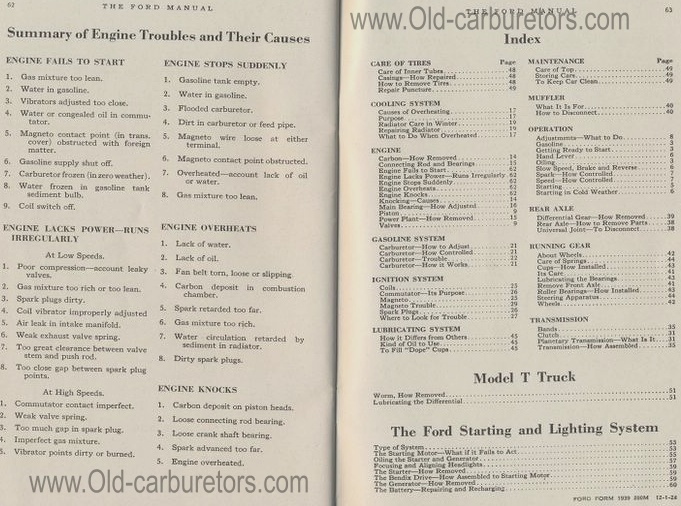First |
Previous Page| Model T Home
62 THE FORD MANUAL THE FORD MANUAL 63
Summary of Engine Troubles and Their Causes Index
ENGINE FAILS TO START
1. Gas mixture too lean.
2. Water in gasoline.
3. Vibrators adjusted too close.
4. Water or congealed oil in commutator.
5. Magneto contact point (in trans. cover) obstructed with foreign matter.
6. Gasoline supply shut off.
7. Carburetor frozen (in zero weather).
8. Water frozen in gasoline tank sediment bulb.
9. Coil switch off.
ENGINE LACKS POWER—RUNS IRREGULARLY
At Low Speeds.
1. Poor compression—account leaky valves.
2. Gas mixture too rich or too lean.
3. Spark plugs dirty.
4. Coil vibrator improperly adjusted
5. Air leak in intake manifold.
6. Weak exhaust valve spring.
7. Too great clearance between valve stem and push rod.
8. Too close gap between spark plug points.
At High Speeds.
1. Commutator contact imperfect.
2. Weak valve spring.
3. Too much gap in spark plug.
4. Imperfect gas mixture.
5. Vibrator points dirty or burned.
ENGINE STOPS SUDDENLY
1. Gasoline tank empty.
2. Water in gasoline.
3. Flooded carburetor.
4. Dirt in carburetor or feed pipe.
5. Magneto wire loose at either terminal.
6. Magneto contact point obstructed.
7. Overheated—account lack of oil or water.
8. Gas mixture too lean.
ENGINE OVERHEATS
1. Lack of water.
2. Lack of oil.
3. Fan belt torn, loose or slipping.
4. Carbon deposit in combustion chamber.
5. Spark retarded too far.
6. Gas mixture too rich.
7. Water circulation retarded by sediment in radiator.
8. Dirty spark plugs.
ENGINE
KNOCKS
1. Carbon deposit on piston heads.
2. Loose connecting rod bearing.
3. Loose crank shaft bearing.
4. Spark advanced too far.
5. Engine overheated.
CARE OF TIRES
Care of Inner Tubes 48
Casings—How Repaired 48
How to Remove Tires 48
Repair Puncture 49
COOLING SYSTEM
Causes of Overheating 17
Purpose 17
Radiator Care in Winter 19
Repairing Radiator 19
What to Do When Overheated 17
ENGINE
Carbon—How Removed 14
Connecting Rod and Bearings 15
Engine Fails to Start 62
Engine Lacks Power—Runs Irregularly 62
Engine Stops Suddenly 62
Engine Overheats 62
Engine Knocks 62
Knocking—Causes 14
Main Bearing—How Adjusted 16
Piston 9
Power Plant—How Removed 15
Valves 9
GASOLINE SYSTEM
Carburetor—How to Adjust 21
Carburetor—How Controlled 21
Carburetor—Trouble 22
Carburetor—How it Works 21
IGNITION SYSTEM
Coils 25
Commutator—Its Purpose 26
Magneto 25
Magneto Trouble 29
Spark Plugs 26
Where to Look fox Trouble 27
LUBRICATING SYSTEM
How it Differs from Others 45
Kind of Oil to Use 45
To Fill "Dope" Cups 45MAINTENANCE Page
Care of Top 49
Storing Cars 49
To Keep Car Clean 49
MUFFLER
What It Is For 40
How to Disconnect 40
OPERATION
Adjustments—What to Do 8
Gasoline 3
Getting Ready to Start 3
Hand Lever 6
Oiling 3
Slow Speed, Brake and Reverse 6
Spark—How Controlled 7
Speed—How Controlled 7
Starting 5
Starting in Cold Weather 6
REAR AXLE
Differential Gear—How Removed 39
Rear Axle—How to Remove Parts 38
Universal Joint—To Disconnect 38
RUNNING GEAR
About Wheels 42
Care of Springs 44
Cups—How Installed 43
Its Care 41
Lubricating the Bearings 43
Remove Front Axle 41
Roller Bearings—How Installed 43
Steering Apparatus 44
Wheels 42
TRANSMISSION
Bands 35
Clutch 31
Planetary Transmission—What Is It 31
Transmission—How Assembled 35
Model T Truck
Worm, How Removed 51
Lubricating the Differential 51
The Ford Starting and Lighting System
Type of System 53
The Starting Motor—What if it Fails to Act 53
Oiling the Starter and Generator 55
Focusing and Aligning Headlights 57
The Starter—How Removed 59
The Bendix Drive—How Assembled to Starting Motor 59
The Generator—How Removed 59
The Battery—Repairing and Recharging 60
FORD FORM 1939 200M 12-1-24
